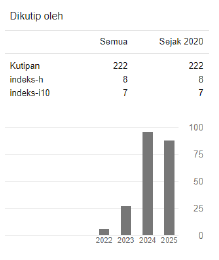Modified Idea Listing Technique with Flash Card to Increase Students’ Writing Ability towards EFL Learners
 https://doi.org/10.54012/ijcer.v2i3.243
https://doi.org/10.54012/ijcer.v2i3.243
 Abstract views: 183
Abstract views: 183
 PDF downloads: 187
PDF downloads: 187
Keywords:
idea listing technique, writing skill, flash cardAbstract
The aim of this study was to find out the significant difference in modified the idea listing technique (ILT) with flash card toward the students’ writing ability. The quantitative research would be conducted in this research and the participants would be focused in the eighth grade of MTs Raudhotul Jannah, Central Lampung. The data would be gained by contributing the pre-test and post- test. Then, to collect the data, it was analyzed by using SPSS version 25.0. The data was analyzed by using paired samples T-test. The result showed that mean of post-test is higher than pre-test and two tail significance is .000 which is lower than α = .05 (p = .000 < α = .05). As a result, the hypothesis is accepted. It is revealed that the modified ILT with flash card is one of the factors which influences the students’ writing ability. Therefore, the result of this research showed that by using modified ILT with flash card, it was more significant differences in teaching writing ability. Furthermore, the writing aspects of modified ILT can increase in students’ writing ability. So, it can be concluded that modified ILT with flash card can increase the students’ writing ability.
Downloads
References
N. Rahmadani, F. Rahman, and L. Swastina, “Students’ Satisfaction and Motivation in Learning Grammar mediated by Quizizz,” Int. J. Corner Educ. Res., vol. 1, no. 2, pp. 104–112, 2022, doi: 10.54012/ijcer.v1i2.100.
A. Eka prasasty, “Analysis of Code Switching as a Communication Strategy among the Students in Pandemic Era,” J. Corner Educ. Linguist. Lit., vol. 2, no. 1, pp. 19–24, 2022, doi: 10.54012/jcell.v2i1.50.
S. Wahyuningsih, P. Nafisah, N. Mulyono, and Y. Hidayat, “Utilization of SQ3R Method to Enhance English Reading Skills: Students’ Voices in The Indonesian Higher Education Context,” Int. J. Corner Educ. Res., vol. 2, no. 1, pp. 17–22, 2023, doi: 10.54012/ijcer.v2i1.175.
D. M. Vidhiasi, “Implementation of Repetition and Chain Drill at Akademi Maritim Nusantara Cilacap,” J. Corner Educ. Linguist. Lit., vol. 2, no. 1, pp. 53–63, 2022, doi: 10.54012/jcell.v2i1.54.
E. Lesiak-Bielawska, “Key aspects of ESP materials selection and design,” English Specif. Purp. World, vol. 46, no. 46, pp. 1–26, 2015.
N. A. Solikhah and R. A. Sari, “Influence of Summarizing Short Stories Towards Students’ Narrative Writing Ability,” J. Corner Educ. Linguist. Lit., vol. 1, no. 3, pp. 176–190, 2022, doi: 10.54012/jcell.v1i3.34.
L. Septia, E. Nurchurifiani, and S. Wahyuningsih, “Improving Students’ Writing Ability through Small Group Discussion Technique,” J. Corner Educ. Linguist. Lit., vol. 2, no. 2, pp. 130–139, 2022, doi: 10.54012/jcell.v2i2.79.
S. ‐A Kim, “Types and Sources of Problems in L2 Reading: A Qualitative Analysis of the Recall Protocols by Korean High School EFL Students,” Foreign Lang. Ann., vol. 28, no. 1, pp. 49–70, 1995, doi: 10.1111/j.1944-9720.1995.tb00769.x.
H. M. Sidek and H. A. Rahim, “The Role of Vocabulary Knowledge in Reading Comprehension: A Cross-Linguistic Study,” Procedia - Soc. Behav. Sci., vol. 197, no. February, pp. 50–56, 2015, doi: 10.1016/j.sbspro.2015.07.046.
H. D. Brown, Principles of Language Learning and Teaching, Fifth., vol. 57, no. 3. United States: Pearson Longman, 2006.
Y. Hidayat and A. Herniawati, “Realization of Genre Analysis on Students’ Essay: A Classroom Discourse Perspective,” J. Corner Educ. Linguist. Lit., vol. 3, no. 1, pp. 40–48, 2023, doi: 10.54012/jcell.v3i1.171.
J. B. Heaton, Writing English Language Tests, New Edition. New York: Longman Group UK Limited, 1988.
D. Nunan, Language Teaching Methodology. London: Prentice Hall International, 2003.
C. Gray and J. Klapper, Key aspects of teaching and learning in languages. 2009.
H. D. Brown, Principles of Language Learning and Teaching, 6th ed. Upper Saddle River: Pearson Education (US), 2007.
Y. Fadhila and S. Fatimah, “Using Idea Listing Technique (ILT) in Teaching Writing Recount Text To Junior High School Students,” J. English Lang. Teach., vol. 9, no. 1, pp. 1–10, 2020, [Online]. Available: http://ejournal.unp.ac.id/index.php/jelt%0AUSING.
H. F. Labibah, “The Effect of English Vocabulary Card Media on Improving Student Learning Achievement at SMAN 1 Tubaba,” Int. J. Corner Educ. Res., vol. 2, no. 1, pp. 41–49, 2023, doi: 10.54012/ijcer.v2i1.192.
W. Grabe, “Key Issues in L2 Reading Development,” 4th CELC Symp. Proc., pp. 8–18, 2014.
S. Apriyanto and A. Nurhayaty, “Born In Social Media Culture: Personality Features Impact In Communication Context,” in icollit, 2019, pp. 167–175, [Online]. Available: icollit.ums.ac.id/2018.
S. Munir, “Turning Classroom Project into Textbook Design in English for Specific Purposes Subject,” Din. Ilmu, vol. 19, no. 1, pp. 1–11, 2019, doi: 10.21093/di.v19i1.1187.
M. Z. Miftah, “Through Idea Listing Technique,” Jeels, vol. 2, no. 1, pp. 62–83, 2015.
A. Bryman, “Quantitative and qualitative research: further reflections on their integration,” in Mixing methods: Qualitative and quantitative research, Routledge, 2017, pp. 57–78.
J. Creswell, Research design: Qualitative, Quantitative, and Mixed Methods Approaches, Fourth Edi. United States: SAGE Publication, 2014.
K. D. Rahayu, D. A. Novitasari, and R. Mirantika, “Students’ Collaborative Writing Method in Pre-Writing Phase,” IDEAS J. English Lang. Teach. Learn. Linguist. Lit., vol. 8, no. 2, pp. 471–482, 2020, doi: 10.24256/ideas.v8i2.1615.
Downloads
Published
How to Cite
Issue
Section
License
Copyright (c) 2024 Ahmad Asrofi

This work is licensed under a Creative Commons Attribution-ShareAlike 4.0 International License.









